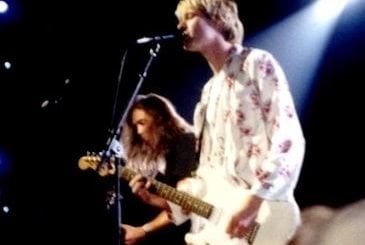Big Long Now by Nirvana Lyrics Meaning – Unraveling the Threads of Existential Musings
- Music Video
- Lyrics
-
Song Meaning
- The Chill of Anonymity: Can We Show Our Faces Now?
- Not Interesting, Not Turning Green: The Struggle with the Mundane
- The Paradox of Perception in ‘Color Blind’: Cobain’s Artistic Conundrum
- Echoes of Ambiguity in ‘Why Can’t I Hear?’: A Sonic Enigma
- Unraveling the Mystery Behind ‘Big Long Now’: A Hidden Meaning in Plain Sight
Lyrics
Please put this side up
She is moving through
Can we show our faces now?
I’m not interesting
She’s not turning green
Shameful as it seems
Can we show our faces now?
Endless climb
I am blind
Why can’t I hear?
Color blind
Speaking a phrase
Instantly grown
I am blind
Waiting in line
It’s not cold enough
Please put this side up
She is moving through
Can we show our faces now?
I’m not interesting
She’s not turning green
Shameful as it seems
Can we show our faces now?
Endless climb
I am blind
Why can’t I hear?
Color blind
Speak a phrase
Instantly grown
I am blind
Why am I sure?
Plunging into the gritty depths of ‘Big Long Now,’ one of the more obscure tracks from Nirvana’s repertoire, reveals a raw narrative that thrums with an existential pulse. While not as widely discussed as ‘Smells Like Teen Spirit’ or ‘Come As You Are’, this track from the 1989 session, surfaced posthumously on the compilation album ‘Incesticide’, is deserving of a deep-dive into its haunting complexity.
Scrutinizing the desolate lyrics penned by Kurt Cobain, ‘Big Long Now’ opens itself up like a jagged wound, inviting listeners to ponder its stark portrayal of human vulnerability, the quest for identity, and the maddening pursuit of meaning in the abyss of the mundane.
The Chill of Anonymity: Can We Show Our Faces Now?
The chilling refrain, ‘Can we show our faces now?’ that perforates ‘Big Long Now’ is not a question so much as a yearning for authenticity. Cobain’s lyrics often flirted with the theme of genuine expression versus societal expectation, and this song is no exception. In a world foundationally obscured by metaphorical facades, this line becomes a piercing cry for the unmasking of true selves, the dropping of pretenses, and the liberation from the endless climber’s facade.
This plea for transparency is made more palpable by the song’s minimalist instrumentation; it serves as a backdrop that amplifies the isolation and rawness of Cobain’s vocal delivery. Every repetition is a hammer strike to the facade, a desperate bid to crack open a surface and reveal what lies beneath.
Not Interesting, Not Turning Green: The Struggle with the Mundane
Cobain characterized himself and his subject as ‘not interesting’ and ‘not turning green’, invoking a sense of stagnation and lack of transformation. This stark self-assessment strips away any illusions of grandeur or growth, speaking to the heart of the human condition in which so many feel their existence is not noteworthy. In the face of endless monotony, the individuals in this narrative remain unchanged, untouched by the passage of time or the experiences they undergo.
The use of the color green is a masterful stroke, alluding to the notion of envy—or perhaps even sickness—that is expected as a natural human reaction, yet is absent here. Cobain’s candid expression of ordinariness is both relatable and disarming, encouraging an introspection on our own sense of worth and our place in the world.
The Paradox of Perception in ‘Color Blind’: Cobain’s Artistic Conundrum
With the declaration of ‘Color blind’ and the questioning of auditory perception, Cobain explores the limitations of the senses and the paradoxes inherent in the creative process. This lyrical motif mirrors an artist’s frustration: the blunt inability to perceive or articulate the world in the way that others seem to do naturally. The struggle is internalized; it is the artist’s battle with the self, with the canvas, with the note that fails to resonate.
The frustration of a vision ‘instantly grown’ yet forever incomplete captures a fundamental aspect of Cobain’s music: the raw, the unfinished, the beautifully imperfect. These lines convey a deep-rooted insecurity juxtaposed with an almost nihilistic acceptance of the unknowable nature of existence and subjective experience.
Echoes of Ambiguity in ‘Why Can’t I Hear?’: A Sonic Enigma
The song’s measured tempo and discordant harmonics set the stage for its lyrical proclamation, ‘Why can’t I hear?’ This is the pounding heartbeat of ‘Big Long Now’, where Cobain can be seen grappling with the void of understanding and communication breakdowns. It’s as if the very capacity to make sense of the external world or to connect with it meaningfully is being questioned at a fundamental level.
The auditory plea becomes a symbol for the overarching desolation infused in the song. In an age of overstimulation and instant gratification, this line pierces through the noise, encapsulating the sense of existential deafness that plagues the modern soul.
Unraveling the Mystery Behind ‘Big Long Now’: A Hidden Meaning in Plain Sight
If one dares to look closer, ‘Big Long Now’ unfurls layers of meaning that resonate with Cobain’s central narrative across his body of work. The term ‘Big Long Now’ could be seen as a representation of time itself—an elongated, ceaseless present—that creates an illusion of movement even in stasis. It is an acknowledgment of temporal infinity and the human attempt to find a toehold within it.
The ‘Now’ becomes an expansive, harrowing experience. In its grandeur and formidability lies an invitation to peel back layers and find solace, however fleeting, in the acknowledgment of shared human experience. Cobain, in his plaintive cries, elicits a collective introspective journey into the heart of existence—our big, long ‘now’.








